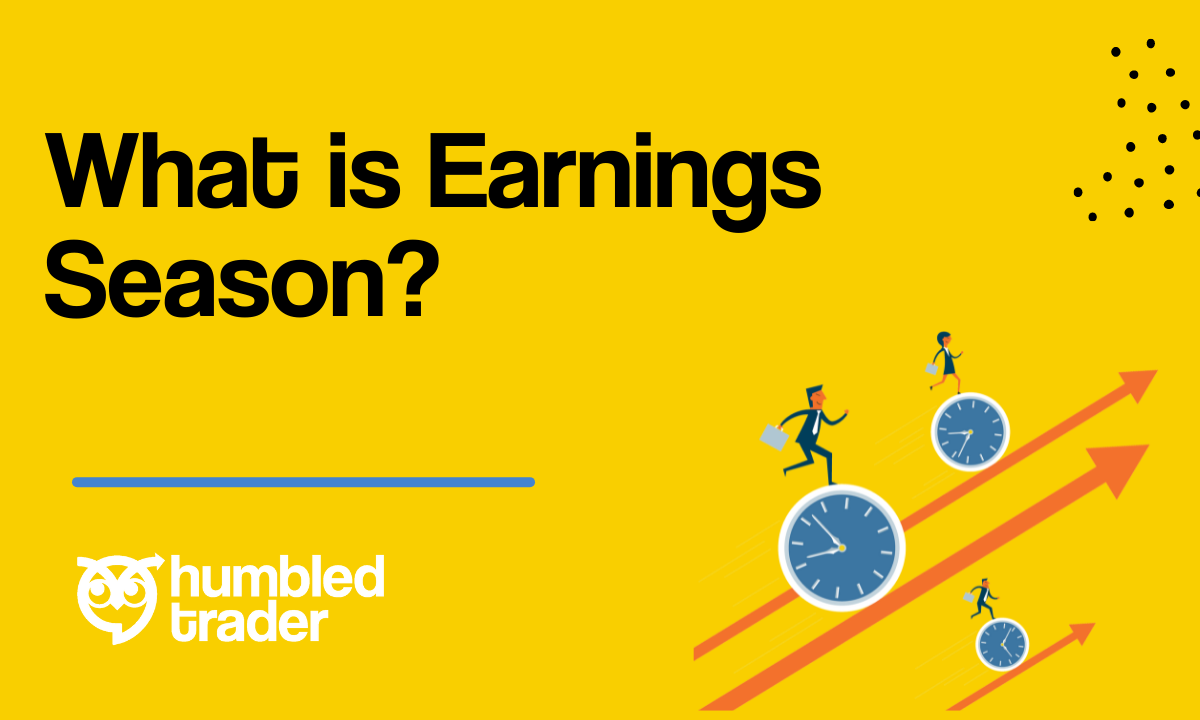What is Earnings Season?

If you’ve been around the block and traded some STONKS, you may have heard of this thing called… “earnings season”.
No, it's not wabbit season nor duck season. It's earnings season. Earnings seasons are exciting times that happen 4 times a year in which publicly traded companies will release their financial results, basically informing their investors of how much money they’ve made in the last quarter.
Depending on the results, these earnings reports can create some volatile moves in some of our favorite stocks, whether it's ripping to the upside, or dumping to a bottomless pit.
Whenever there's this kind of volatility, there's definitely a lot of profits to be made for all of us short-term traders. I've been a trader for more than 7 years now, and these earnings seasons are some of my favorite times to trade
In this article, I’ll be going over exactly what earnings season is and why you should care as a trader or investor as well as how to analyze some key metrics from the financial results, so you won't have to read through 10 pages of 10Q reports. More importantly, I will also share with you some important trading tips for you during these volatile times.
Background
Let's start from the very beginning; what is Earnings season? Earnings season occurs four times a year. It's a period of time when publicly traded companies are required to report to their investors how much money the company has made in the last quarter.
This is important, because Wall Street analysts rely on these earnings results to determine the value of a stock, and many institutional and retail investors use these metrics and the sentiment to determine whether they want to buy a stock.
Or just GTFO because… this baby is taking on huge losses and isn't making any more money for the company or the investors.
Like we mentioned, Earnings season occurs 4 times a year, each lasting around 6 weeks. Yes, your favorite stocks: TSLA, AMD, NFLX and even our bff’s GME and AMC will do these earnings presentations every 3 months.
Don't worry if you just missed the last one. You will still have many more chances to YOLO… I mean trade or invest in these stocks during this year.
Remember, per regulations, these publicly traded companies are required to report their financials, update investors on how they’re doing and provide any upcoming events or drastic developments within the business.
Individual companies’ earnings dates are announced usually a few weeks before the actual earnings report. The conference calls can be hosted Monday to Friday during regular trading weeks.
The actual times of the reports are usually before the market opens first thing in the morning or after the market closes in the afternoon. Most companies, at least the big tech names like GOOG, AAPL, AMZN or FB, release their earnings right after the closing bell at 4 to 4:30.
Because… They don't want to give traders too much of a break before their next yolo, amirite?
What happens when the report is released?
What usually happens on the day of the earnings report is companies will release the key financial metrics, which is basically a quick rundown of how they did in the last quarter. They will post their revenue figures as well as their earnings per share.
Usually, right after the key metrics are shared is when the stocks will start fluctuating afterhours or premarket. If the figures are exceeding Wall Street's expectations, you can see the stock rip up after hours.
On the other hand, if the company releases disappointing financial results, well the stock would also rip too.
Don't worry, we’ll dive into the details of what these metrics mean and how to analyze them as a trader or investor in just a little bit.
Following the initial financial results like earnings per share and revenue, there will be a more in-depth conference call with the CEO, CFO and COOs. That's where they dive into details of the business such as balance sheets, new product release, consumer trends or even competition concerns.
Investors can tune into their live earnings call online, or you can read the transcripts or even the company’s 10Q or 10K the next day online.
Now, I know you most likely don’t have the time to read through the entire 10 pages of the 10K report on the SEC website. That's why we’re going to talk about some key figures most investors and Wall Street use to analyze whether a stock is a buy, hold or dump.
Key Metrics
Earnings Per Share
The first key metric is earnings per share, abbreviated as EPS. Earnings per share (EPS) is calculated by taking the company’s net profit divided by the number of outstanding common stock.
For example, if my ex-husband’s publicly traded company, Bagholder Trading limited reported that they made $1,000 in profit during the last quarter, and they also have 1,000 total stock shares available (also called Shares Outstanding), then we take $1,000 and divide that by 1,000 shares to get an EPS of $1 per share.
Vice versa, if Bagholder Trading limited reported they didn’t make any money, instead they had a loss of $1,000, the EPS would be negative -$1/sh. That’s a pretty big loss. The moral of the story here is, kids, don't baghold like my ex-husband.
Revenue
The next key metric to look at from the earnings report is revenue. Basically, revenue is the amount of money the company makes from providing its services or products to consumers.
Even though having a very positive revenue does not mean a company is highly profitable since none of the costs are considered, investors still value this revenue metric, because a growing revenue is the number one driving factor that could eventually lead to higher profits.
Essentially, if a company can have increasing revenue year over year, this shows growth to their investors. This is important in tech companies or growth stocks in general, since Wall Street follows the statement, “If you’re not growing, you’re in the process of dying.”
That's why AMD (Advanced Micro Devices) stock soared after hours after their Q4 earnings report on Feb 1, 2022. Not only did they announce they have an EPS of $0.92, they also have a very bullish 49% year-over-year revenue growth.
Another great example is GOOG(Google). They also released their Q4 earnings on the same day as AMD. Google also had some blow out numbers as well. They had earnings of $30.69 per share, and 32.4% year over year revenue growth.
Upside Guidance
In both of these examples, AMD and GOOG also had another very bullish factor. They issued upside guidance, which is the third key metric to look out for when reading a company's earnings reports.
In simplest terms, a company’s guidance is how much money they are expected to make in the future, and whether they are projecting their revenue to grow. Guidance is often discussed in depth during the actual conference calls after the initial financial metrics are released.
Remember, the stock market is forward-looking. While it's great and reassuring for investors to know that companies like AMD or GOOG have made a lot of money in the past quarter, investors care even more about whether the company is expecting to make even more money in the future.
Both of these stocks we just mentioned did not disappoint. They both issued upside guidance and forecast even more growth in 2022.
However, for PYPL (Paypal), META (Meta), these companies are projecting a slow down in growth and subsequently making less money in 2022. That's why all of these stocks dumped after hours and continued to lower for many days after.
Remember, these three key metrics in earnings reports: earnings per share, revenue growth and guidance are really just the surface of the story. Understanding these three is enough for short term day trading or even swing trading.
However, if you are a long-term investor, I would highly recommend you read the entire earnings transcript or tune into the earnings calls live.
How to Take Advantage of Earning Seasons?
Alright, so now we understand the three key metrics to look at, how exactly can we, both day traders and swing traders, take advantage of raining Lamborghini opportunities that happen 4 times a year?
Anticipation
The first thing for us traders is to look for the anticipation to move into earnings. Stocks that have a big following or just enough weight to move the indices often can make huge moves up or down into earnings.
For example, stocks like TSLA (Tesla), AAPL (Apple), META and AMD are some of the most anticipated stocks that traders love to trade. Generally speaking, if the sentiment and the market environment is expecting a company to release very positive earnings, the stock could rip up and run into earnings.
Keep that in mind if you are trading stocks that have earnings coming up soon within a week or so. If you see that analysts are expecting them to do well, and the bids hold up while seeing consistent options call sweeps, then there may be opportunities on the long side to join the rally.
However, this is obviously not applicable to all stocks. In a fearful market environment, such as during the pandemic, or the high inflation and rising interest rate environment we are in right now, regardless of whether there is any hype for earnings, many stocks sell off like a bottomless pit. Just be very careful, and take into consideration all factors here.
Short-Term Trading Positions
The second tip I have for you, and one that I think is an important one especially if you are a new trader is to never, I repeat, never hold your short-term trading positions into earnings.
This is a true 50/50 gamble. A stock can beat on earnings and still tank. It could also miss on earnings and take off like a rocket.
I’ve actually had personal experiences holding trading positions into earnings in my first year of trading. I was new and naive and really wanted that one home run trade. Let me just tell you, the profits from trading into earnings are often very small, in comparison to the losses. The risk is just not worth it unless you have only a small partial position, or if you’re hedged with options.
After so many years of trial and error, my preferred way to trade during earnings season is to trade the gap ups or gap downs the next day, after the full earnings reports have been released.
After Hours Action
That is my third tip for you traders; take the time to fully analyze the afterhours action on some of these stocks that made huge moves. Use the time to observe how similar industry stocks reacted after earnings.
For example, you can study AMD earnings and its price action, to prepare for NVDA (NVIDIA) earnings. You can look at big tech with a high weight in the cloud business such as MSFT (Microsoft) and use that as a comparable to GOOG and even AMZN (Amazon).
By waiting until the next day, you now have the time to truly analyze and read the conference call transcripts to get a full understanding of all the three metrics we talked about: EPS, revenue and guidance, and trade the premarket moves the next day accordingly.
Conclusion
Hopefully, this article provided you with a better understanding of the earnings season that happens four times a year, and an introduction on how to approach each earnings season as a trader.
If you’re looking for more in-depth trading strategies to trade these overnight gap ups or downs after earnings reports, then feel free to check out the Humbled Trader Academy on my website. I talk about trading earnings in even more detail in the program.
These are exciting times that lead to a lot of volatility for us traders to capture some profits, and hey guess what, even if you miss one this time around, there will always be another time in 3 months.
Don’t feel like reading? Watch the video.




